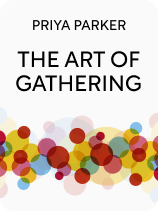

This article is an excerpt from the Shortform book guide to "The Art of Gathering" by Priya Parker. Shortform has the world's best summaries and analyses of books you should be reading.
Like this article? Sign up for a free trial here.
What is Priya Parker’s The Art of Gathering about? What are the main takeaways of the book?
In The Art of Gathering, Priya Parker discusses what to do before a gathering to set the stage for a potentially transformative experience. Then she shares how to begin and end the gathering in a meaningful way so that you and your guests will have a great time.
Read below for a brief overview of Priya Parker’s The Art of Gathering.
The Art of Gathering by Priya Parker
Have you ever attended a conference and spent the entire time waiting for it to end? Have you ever gone to a wedding and felt there was something missing?
In Priya Parker’s The Art of Gathering, she contends that pre-planned gatherings of all types—both business and personal—could be meaningful experiences, but too many gatherings miss the opportunity to become so. In her book, Parker presents a step-by-step guide to transforming your gathering into a meaningful event that people will be talking about for years to come.
What to Do Before the Gathering
Parker argues that what you do before the gathering is just as important as what you do during the gathering itself. She shares five essential tips: Identify the reason, curate your guest list, select a venue, create directives, and set expectations.
Identify the Reason
According to Parker, the first thing you should do when planning your gathering is to identify the reason, or “purpose,” for which you’re gathering. You should have one clear, distinct, and specific reason for gathering that’s not defined by the type of gathering you’re having. For example, a bachelorette party is not a reason; “give my bridesmaids a chance to bond with each other before the wedding” is. Why do you need a reason? Parker explains that without one, you might gather in unhelpful ways. This may result in a missed opportunity to do something meaningful. Alternatively, you might gather in ways that are antithetical to your values; this can happen when you follow traditional customs because you find the custom itself significant but not the original reason the custom was developed.
Additionally, Parker argues that when you have one specific reason for gathering, you can use this reason as a guideline by which to evaluate all the decisions you make at the gathering. A specific reason makes decision-making easier because it presents a clear path to follow, whereas a general reason can be ambiguous and open up too many options when you’re trying to decide on something.
To discover your reason, Parker recommends that you repeatedly ask yourself why you’re gathering until you discover an underlying conviction. For example, if you want to have a bachelorette party, ask yourself why that matters.
Curate Your Guest List
Once you’ve decided on a reason for gathering, the next step is to curate your guest list. In other words, decide who helps you fulfill your reason—then invite only those people.
Parker explains that despite how it may seem at first glance, limiting your guest list is a compassionate act. If you invite people who don’t support your reason, they may actively sabotage it. But even if they don’t, they’ll still undermine your reason because they’ll inevitably distract you (as the host) with their presence. As a result, you won’t give your full attention to the guests for whom the gathering is designed. In this way, not inviting people who don’t actively support your reason is an act of compassion toward the guests you do invite.
When limiting the size of your gathering, Parker recommends that you keep in mind both who and how many people support the purpose. If you want a small, intimate group, limit your gathering to six to 12 people. If you want to foster intimacy while still allowing for diverse perspectives, you can have up to 15 people. For a more animated, party-like vibe, invite 30 people. And if you want a big gathering, a group of 150 people feels large but still connected.
Select an Appropriate Venue
Once you know how many people are coming to your gathering, select an appropriate venue. Parker explains that an appropriate venue has three important qualities. First, it will immerse your guests in the reason for the gathering and thus enhance their experience. Second, it will encourage the conduct you desire (and discourage conduct you don’t want), as people are primed to behave differently depending on the environment. Third, it will encourage unexpected behavior in your guests—in this case, a slightly unexpected venue will help.
Create Directives
The fourth pre-gathering step, according to Parker, is to create directives, which she calls “pop-up rules.” In other words, give specific instructions about how you’d like your guests to behave during the event—such as that they should all bring a particular type of dish—and clearly communicate them to your guests.
Parker recommends creating directives for two reasons. First, clear directives make diverse gatherings more comfortable. Many hosts expect their guests to behave according to certain defined protocols. However, this expectation often backfires in an increasingly multicultural world. If your guest list is diverse, they will have different (and potentially clashing) cultural expectations for what is appropriate; for example, a Japanese person will expect guests to help them clean up after a house party, while an American might find this practice insulting. Clear directives remove a lot of potential friction and pave the way for a smoother gathering.
Second, Parker argues that clear directives encourage engagement. For example, people are often glued to their cell phones—even in situations when checking their phone is generally considered rude. But if you temporarily ban cell phones during your gathering, the short-term nature of this directive will make it seem more like a rule of a game. As a result, your guests will find pleasure in ignoring their cell phones rather than feeling restricted—and thus be more engaged within your gathering.
Set Expectations
The fifth pre-gathering step, according to Parker, is to set expectations. While most hosts assume that the gathering begins when everybody arrives, Parker argues that in reality, the start of your gathering is whenever you tell a guest about it. So during the lead-up to your gathering, you should set expectations with your guests so that they have a clear idea of what will happen.
Parker contends that setting clear expectations during the lead-up to your guests’ arrival is essential for two reasons. First, setting expectations will help your guests get into the right mood. As a result, they’ll arrive at the gathering feeling more open to fully participating in the experience. Second, setting expectations prevents guests from feeling cheated. It reduces the possibility that your guests will feel disappointed because their own (incorrect) expectations for the gathering were unfulfilled.
How to Begin the Gathering
After you’ve completed all the pre-gathering steps, the day of your gathering will come and your guests will start to arrive. But, Parker argues, if you don’t handle these moments right, all that pre-gathering work will have been wasted. For the best possible gathering, Parker suggests that you pay attention to two key moments: the arrival and the opening.
Manage Your Guests’ Arrival
Parker suggests that you manage your guests’ arrival by introducing a clear physical or metaphorical transition into your gathering. When your guests arrive, they will be mentally wrapped up in whatever else is going on in their lives—like the fight they just had with their sister. By providing them with an appropriate transition, you encourage them to forget about everything else and refocus their attention on your gathering so they can be fully engaged.
The simplest and most literal transition, Parker points out, is a doorway. What you do at the door can help shape your guest’s experience; for example, greeting your guests at the door as if you’re at a wedding will help set a more personal tone for your event. You can go one step further and decorate a hallway in keeping with your event—just as Disneyland designs the hallway into their rides with thematically related items. Alternatively, create a psychological transition. Parker describes how one comedian, prior to starting his set at a charity event, captured the attention of his audience by asking the loudest member of several conversational groups to introduce themselves and then asking everybody to clap.
Open Right
After properly transitioning into your gathering, turn your attention to the opening. Parker explains that you must open in a way that sets the tone for the gathering.
Parker argues that opening right matters: Studies suggest that most people tend to remember beginnings—so how you open will linger most in people’s memory. However, most hosts at gatherings open with organizational matters, such as by thanking sponsors. At best, opening with organizational matters misses an opportunity to harness the pre-gathering momentum you’ve created into a powerful moment. At worst, it may undermine the reason for gathering. For example, if you frame a conference as game-changing and disruptive but start with a boring list of rules, you send the message that you’re following old rules.
How to Behave During the Gathering
Just as important as how you behave before your gathering is how you behave during the gathering. In this section, we’ll dispel the three misconceptions that Parker believes harm your gathering—and share her recommendations on how to behave instead.
Misconception #1: The Host Should Relax
The first harmful misconception, according to Parker, is the idea that the host should relax, or “chill.” Hosts who think they should relax leave guests to their own devices—such as by letting guests roam around the venue unrestricted. These hosts see their refusal to direct the gathering as an act of kindness that will result in a laid-back, undirected affair. But in reality, if a host doesn’t direct his own affair, someone else will—usually in a manner that ruins the gathering for everybody else.
Instead, Parker recommends that you shift your mindset and deliberately direct the gathering. In other words, you must use your power as a host to make your guests do things they might not choose themselves. If this seems too stuffy, remind yourself that deliberate direction is kinder than relaxing—as long as it’s motivated by a desire to provide your guests with a maximally fulfilling experience. If you’re motivated by anything else (like a desire to seem more important), you’ll detract from, rather than enhance, your guests’ experience.
Misconception #2: Be Positive
The second harmful misconception, according to Parker, is the idea that everybody should be positive. When we gather—whether at a party or conference—most of us put on a show: We present ourselves as strong and confident, and we hide our vulnerabilities. Parker argues that this is a missed opportunity to connect with others. If your guests tell stories that reveal their vulnerability, other guests will feel more empathetic toward them. As a result, they’ll all feel more authentically connected to each other. At the very least, this authentic connection will make for a more memorable gathering; at its best, a deeper connection can allow for greater cooperation.
Misconception #3: Be Peaceful
The third harmful misconception, according to Parker, is the idea that all gatherings must be peaceful. Parker argues that in the modern world, most of us act as if we should avoid heated disagreements. Even universities—ostensibly institutions designed to encourage argument—shy away from anything too controversial, such as by rescinding invitations to speakers who draw student protests.
However, Parker warns that prioritizing peace above all else can sometimes backfire and undermine your reason for gathering. Certain gatherings require that long-simmering tensions be brought out into the open and worked through—whether that’s because the gathering is about a controversial topic or because the group’s work outside the gathering is being hampered by these tensions. For example, you might hold a debate about gun control, or you might have educators who need to create a curriculum but are debating what kind of ideas they want to teach their students. If you avoid this requirement, you won’t effectively discuss or work through any of these issues—and they’ll continue to sow disharmony.
How to Close the Gathering
Eventually, your gathering will have to end—and treating this ending with the respect it deserves will cement the experience in your guests’ minds. In this section, we’ll first explain why deliberately closing your gathering matters. Then, we’ll share Parker’s advice on closing the gathering in a way that honors the rest of your work.
Parker explains that deliberately closing your gathering is essential because it provides your guests with a transition. As Parker notes, endings are inherently sad, so many people deliberately avoid officially closing their gathering. For example, the party host lets the guests trickle out rather than signaling that they should go home.
However, Parker argues that not deliberately closing your gathering does your guests a disservice. If you’ve hosted well, you’ve created a transformative experience—and, just as you helped your guests transition from their regular lives to the experience of your gathering at its beginning, it’s also your duty to help them accept the end of this experience and transition back into their normal lives.
So how do you help them transition? The first step, according to Parker, is to signal the end to your guests. Figure out a way to let them know that things are drawing to a close and so they should behave accordingly. If you’re not sure when to signal this (like if you’re hosting a party with no set endpoint), do it when you feel that the gathering has fulfilled its reason but is still somewhat lively; if you wait too long, your gathering will lose momentum and end on a less memorable note.
Second, handle organizational matters—such as by telling guests where to return their ID badges. Just as you don’t want to open with organizational matters, you also don’t want to end your guests’ experience with them. If you need to thank someone, do this now.
Third, bring the community together. Do something that allows your guests to remember both what they did at the gathering and how they connected with each other. For example, BTS’s members give short speeches near the end of each concert discussing their experience of that night.
Fourth, prepare your guests for the final transition. This act should allow guests to understand how to relate to other guests they see outside of the gathering and how this gathering will inform their actions in their daily lives. The right party favor can communicate this idea; for example, a bumper sticker reading “hope” might remind people daily to hope more in their lives.
Finally, give them a physical or metaphorical exit to signal the final moments of the gathering. Whether you lead them outside a doorway or tell them it’s the end, the very last moment of your gathering matters. It should communicate to your guests that the gathering has come to a conclusion, let you celebrate what happened, and allow them to return to the outside world.

———End of Preview———
Like what you just read? Read the rest of the world's best book summary and analysis of Priya Parker's "The Art of Gathering" at Shortform.
Here's what you'll find in our full The Art of Gathering summary:
- How to make pre-planned gatherings more meaningful and engaging
- What to do before, during, and after any type of gathering
- Why the host should never relax during their event






